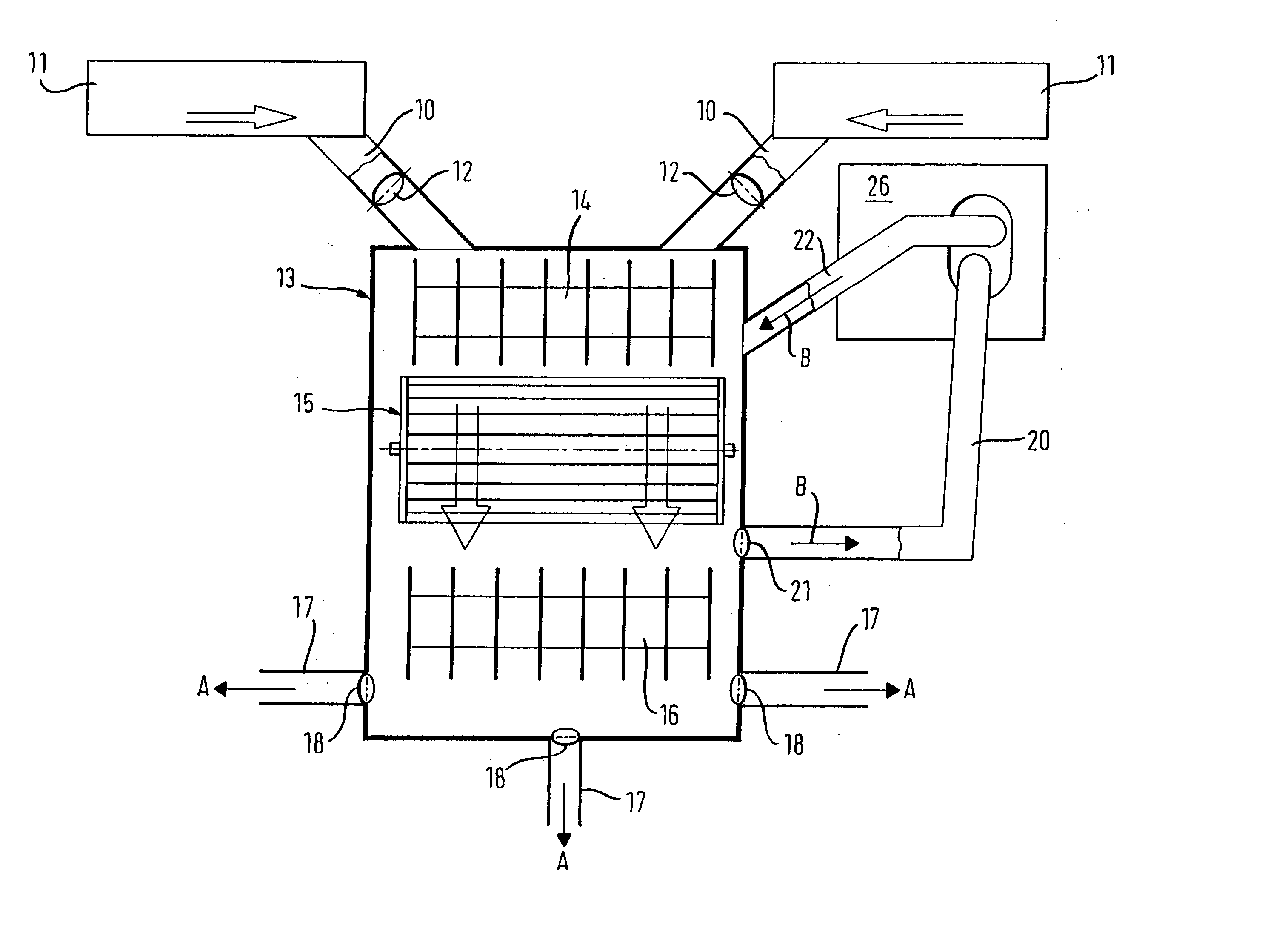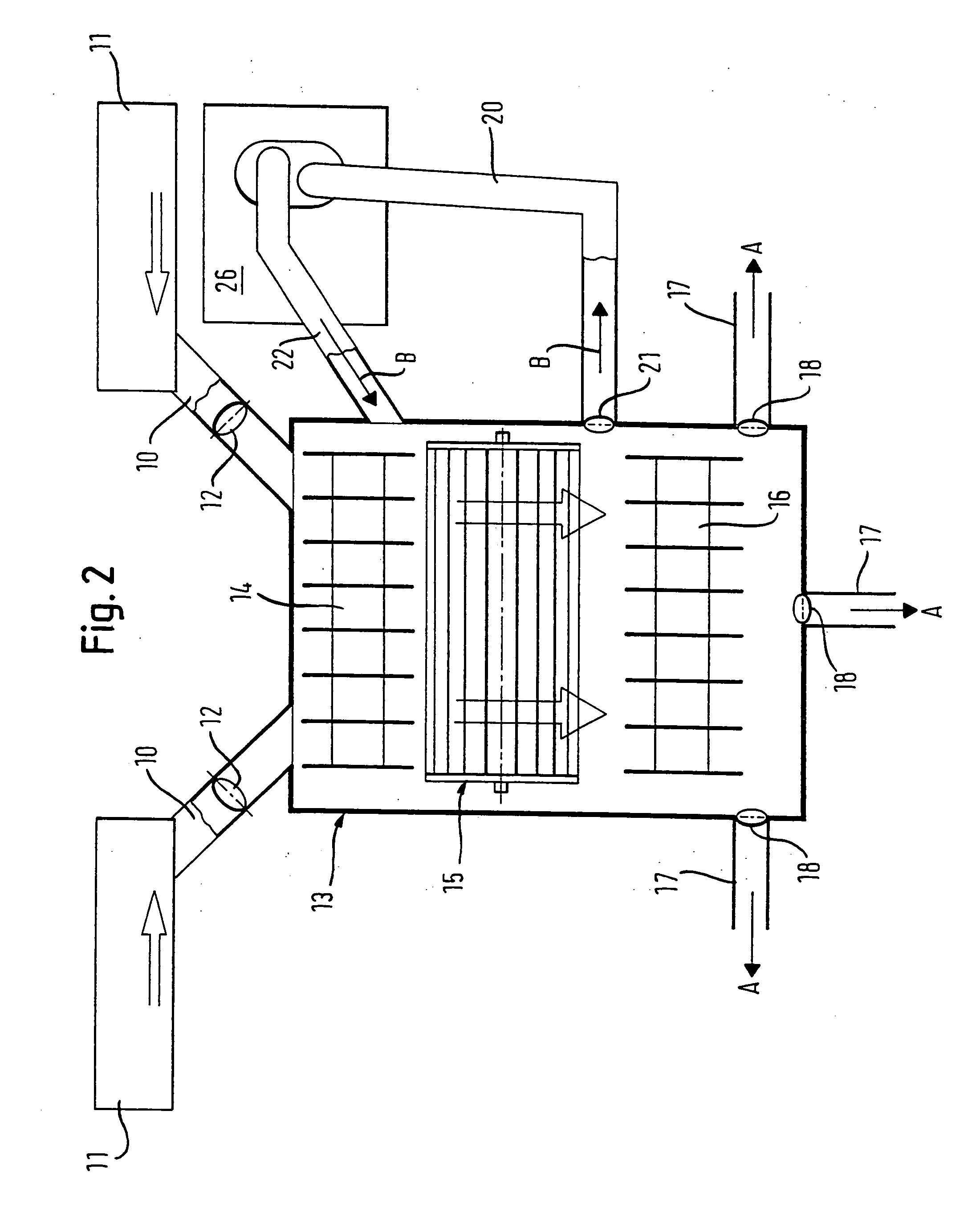[0006] Thus the present invention is based on the idea of using the existing climate control system in a motor vehicle, in the form of a
heating system with blower or an air conditioning system, to cool the motor vehicle's electrical and / or electronic components wherein almost complete compensation for the interference in the climate control system is achieved by recirculating the cooling air into the intake system of the climate control system's fan. In other words, it is possible to facilitate symmetrical tapping of air from the climate control system as cooling air without substantially and noticeably disrupting the symmetry of said climate control system.
[0008] In an advantageous manner, in the combined cooling / climate control system of the present invention, the electrical and / or electronic components are disposed in a closed housing with a
heat exchanger. To cool the electrical and / or electronic components in the housing, the
heat exchanger is provided in a duct which is created from the air supply and air
discharge pipe so that the heat lost by the electrical and / or electronic components can be dissipated by way of the
heat exchanger. In this embodiment the heat exchanger may have several ribs provided on the housing. The heat exchanger may also be replaced by a Peltier element. In addition, the embodiment makes it possible to use a multi-
control unit in the closed housing, which takes over the functions of several electrical and / or electronic components that are connected to functional units of the vehicle's interior or passenger compartment, so that it is possible to dispense with the apparatus rack behind the
dashboard, i.e. on the passenger side in the motor vehicle's “interior”, resulting in a
gain in construction space in the interior of the vehicle. Furthermore, there is a large cooling potential for cooling the electrical and / or electronic components.
[0009] In an advantageous manner, the control units of the motor vehicle's drive system and / or the control units for other functional units of the motor vehicle are accommodated in the closed housing. Amongst the control units of the motor vehicle's drive system, the
motor control unit is especially important as it has a large
power loss and is thus linked to a high level of
heat generation. Therefore, the present invention proposes in this embodiment to take the drive control units, which are conventionally disposed in the E-box, especially the
motor control unit, out of the E-box and to house them alone or together with other control units of the drive system and other functional units in the closed housing, and to dissipate the heat arising by means of the cooling / climate control system according to the invention. In this case the fan provided by reference to the prior art on the E-box may also possibly be dispensed with and may especially be dispensed with if all electrical and / or electronic components with high
power loss are accommodated in the closed housing according to the present invention. The components remaining in the E-box then no longer require a separate cooling system due to the substantially lower power loss. Thus as a result of moving out the high power loss components, it is possible to leave out the E-box fan and do away with the
package problems arising in the E-box due to the small amount of space available. Moreover, as a consequence there is a reduction in the acoustic
exposure drawn into the passenger compartment from the engine compartment and through the fan.
[0010] Thus it is especially advantageous if at least the vehicle's
motor control unit is accommodated in the housing.
[0011] According to a further embodiment of the invention, the air supply and
discharge line is in fluid connection with the motor vehicle's E-box so that the electrical and / or electronic components in the E-box can be cooled by means of the embodiment according to the invention. As a result, in a similar manner to the preceding embodiment, the fan of the E-box becomes superfluous whereby there is a cost saving and the ratio of installation space in the E-box is improved. Furthermore, the E-box is uncoupled acoustically from the passenger compartment so that no or a low level of
noise is dragged in. Moreover, there is no longer any need for an extraction orifice that is connected to the passenger side footwell, which could be blocked by objects in the footwell or through which dust from the footwell can be sucked into the E-box, so that the danger of damaging the electrical and / or electronic components due to overheating or collecting dust can be reduced. Furthermore, it is possible in a simple manner to increase the cooling output in the E-box and accordingly to match it to requirements.
 Login to View More
Login to View More  Login to View More
Login to View More 


